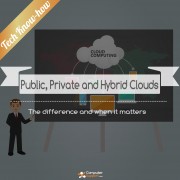Introduction to the Thin Client
The concept of a thin client has been gaining traction these past few years. The overall idea is that a computer relies on another computer for most of its operating capacity. Now that might sound like a bad thing, but it can more efficient. For example, on a typical day, an employee may use maybe ten percent of his computer’s capacity. You’re paying for all the PC’s RAM and processing power, but you and employees rarely use it all. If you had thin client set-up, computing power would be shuffled around by the main server to computers that needed it. There are drawbacks.
Thin clients typically cost less to maintain and last longer than a traditional PC paradigm, but they are expensive to acquire. Thin client servers also fall prey to sudden increases to traffic and distances from computer to serve. Which brings up a valid draw back of thin clients, they don’t adapt to certain situations well. If you suddenly needed another computer you could go out and buy one. However, on a thin client system you’d have to add more capacity to the server.
Drawbacks aside, thin clients seem to be here to stay. You may not know it, but cloud technology is a form of a thin client. Everything from Google Docs to iCloud used the memory storage aspect of a thin client. And with BYOD (bring your own device) policies springing up everywhere, a thin client serve could be a way to integrate all those different gadgets. It’s important to understand that in this day and age, a business never has to adopt a system or way of thinking wholesale. For a smaller business, a cloud hosting service might be useful to backup files rather than a full blown thin client server. Picking a choosing appropriate pieces is a sure fire away to maximize ROI.

